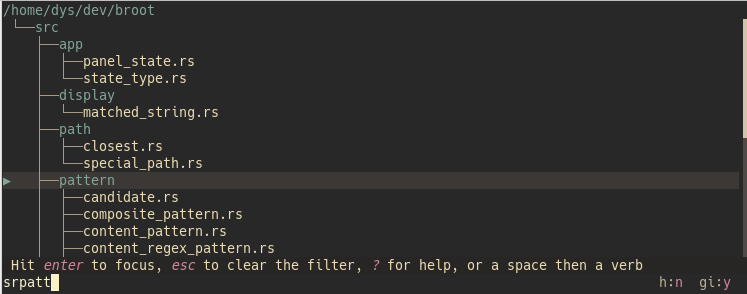Reset
If you want to get back to the default set of configuration files, delete or rename the broot directory in your standard configuration place (e.g. ~/.config/broot).
On next launch, broot will recreate all the necessary files.
Hjson or TOML
Two formats are allowed: TOML and Hjson.
This documentation will often show you the same setting in both formats, with two tabs, like this:
// setting to use if your config file is in .hjson
# setting to use if your config file is in .toml
Opening the config files
The main configuration file is called either conf.toml or conf.hjson.
This default file's location follows the XDG convention, which depends on your system settings. This location in your case can be found on the help screen (use ?).
The default configuration file contains several example sections that you may uncomment and modify for your goals.
It typically imports other files in the same directory.
Imports
A configuration file can import some other files. This eases management, as you may for example define your skin in a file, or the list of verbs in another one.
An import can have as condition whether the terminal is in dark or light mode, so that broot can take the most suitable skin on launch.
All imports are defined in an imports array.
For example:
imports: [
verbs.toml
{
luma: light
file: white-skin.hjson
}
{
luma: [
dark
unknown
]
file: dark-blue-skin.hjson
}
]
This example defines 3 imports.
The first one has the simplest form: just a (relative or absolute) path. This import isn't conditional.
The second import is done only if the terminal's luma is determined to be light.
And the third one is done when the terminal's luma is either dark or couldn't be determined.
Starting from version 1.14, the default configuration is released in several files.
Note
Be careful when installing a configuration file from an unknown source: it may contain an arbitrary command to execute. Check it before importing it
Note
On non linux systems, Background color determination is currently disabled (always "unknown"). This is expected to be fixed.
Default flags
Broot accepts a few flags at launch (the complete list is available with broot --help).
The default_flags entry lets you specify them in configuration, with the same syntax.
For example, if you want to see hidden files (the ones whose name starts with a dot) and the status of files related to git, you launch broot with
br -gh
If you almost always want those flags, you may define them as default in the configuration file file, with the default_flags setting.
default_flags: -gh
default_flags = "-gh"
Those flags can still be overridden at launch with the negating ones. For example, with the above default_flags, if you don't want to see hidden files on a specific launch, do
br -H
Special Paths
You may map special paths to specific behaviors. You may for example
- have some link to a directory to always automatically be handled as a normal directory
- exclude some path because it's on a slow device or non relevant
- have a file be visible even while it's normally ignored
A special paths entry is defined by 3 parameters: show, list, and sum.
Each of them can be default, always, or never.
Example configuration:
special_paths: {
"/media" : {
list: "never"
sum: "never"
}
"~/.config": { "show": "always" }
"trav": {
show: always
list: "always",
sum: "never"
}
"~/useless": { "show": "never" }
"~/my-link-I-want-to-explore": { "list": "always" }
}
[special-paths]
"/media" = { list = "never", sum = "never" }
"~/.config" = { show = "always" }
"trav" = { show = "always", list = "always", sum = "never" }
"~/useless" = { show = "never" }
"~/my-link-I-want-to-explore" = { list = "always" }
Be careful that those paths (globs, in fact) are checked a lot when broot builds trees and that defining a lot of paths will impact the overall speed. When the goal is to have a gitignored file visible, it's more convenient and efficient to use a .ignore file.
Search Modes
It's possible to redefine the mode mappings, for example if you usually prefer to do exact searches:
"search-modes": {
<empty>: regex name
/: fuzzy path
z/: regex path
}
[search-modes]
"<empty>" = "regex name"
"/" = "fuzzy path"
"z/" = "regex path"
The search mode must be made of two parts :
- the search kind: Either
exact,fuzzy,regex, ortokens - the search object: Either
name,path, orcontent
Selection Mark
When the background colors aren't rendered in your terminal, aren't visible enough, or just aren't clear enough for you, you may have the selected lines marked with triangles with
show_selection_mark: true
show_selection_mark = true
Columns order
You may change the order of file attributes in file lists:
- mark: a small triangle flagging the selected line
- git : Git file info
- branch : shows the depth and parent in the tree
- permission : mode, user, group
- date : last modification date
- size : ISO size (and size bar when sorting)
- count : number of files in directories
- name : file name
For example, if you prefer to have the branches left of the tree (as was the default in broot prior 0.18.1) you can use
cols_order: [
mark
git
branch
permission
date
size
count
name
]
cols_order = [
"mark",
"git",
"branch",
"permission",
"date",
"size",
"count",
"name",
]
The name should be kept at end as it's the only one with a variable size.
Colors by file extension
broot doesn't support LS_COLORS which isn't available on all systems and is limited to 16 system dependent colors.
But you can still give a color to files by extension:
ext_colors: {
png: "rgb(255, 128, 75)"
rs: "yellow"
toml: "ansi(105)"
}
[ext-colors]
png = "rgb(255, 128, 75)"
rs = "yellow"
toml = "ansi(105)"
(see here for precision about the color syntax in broot)
Syntax Theme
You can choose any of the following syntaxic coloring themes for previewed files:
- GitHub
- SolarizedDark
- SolarizedLight
- EightiesDark
- MochaDark
- OceanDark
- OceanLight
syntax_theme: OceanLight
syntax_theme = "OceanLight"
Those themes come from syntect and are bundled in broot.
Terminal title
If you set the terminal_title parameter, broot will change the title of the terminal when the current tree root changes.
The pattern allows using the same arguments than verb execution patterns, eg {file} or {git-name}.
terminal_title: "{file} 🐄"
terminal_title = "{file} 🐄"
Preview
Kitty Graphics
Whenever possible, previewed images will be displayed in high resolution using Kitty's graphics protocol.
Two transmission media are possible:
chunks: slow but works remotelytemp_file: faster but doesn't work when broot is remotely executed, default
kitty_graphics_transmission: chunks
#kitty_graphics_transmission: temp_file
kitty_graphics_transmission = "chunks"
#kitty_graphics_transmission = "temp_file"
Transformers
It's possible to define transformers to apply to some files before preview.
This makes it possible for example to render a specific kind of files as images, or to beautify some text ones.
Below are examples that you may adapt to your needs and preferred tools.
They must be included in a preview_transformers array, as shown in the default conf.hjson.
Render PDF using mutool:
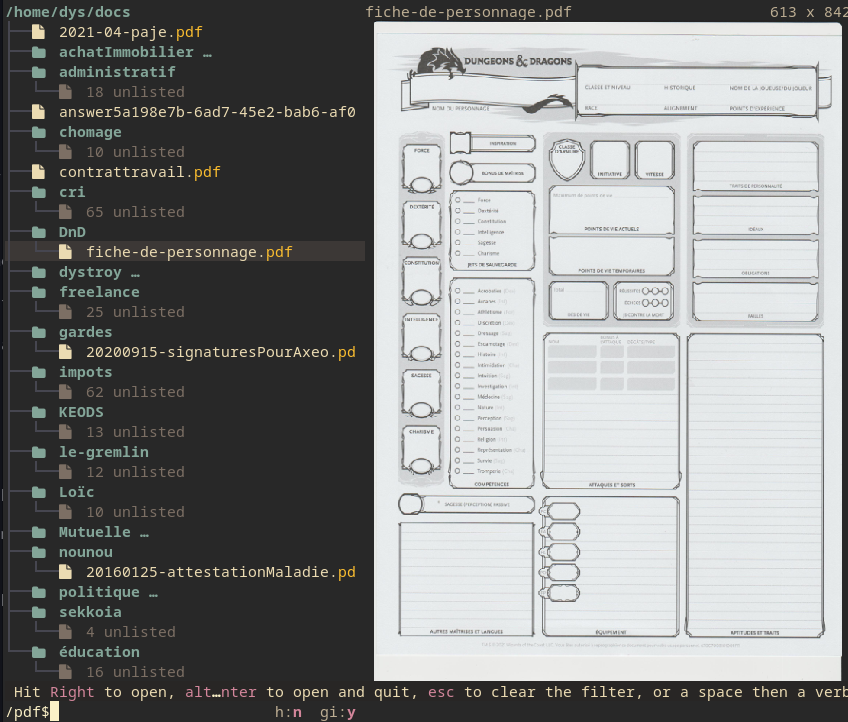
# Use mutool to render any PDF file as an image
# In this example we use placeholders for the input and output files
{
input_extensions: [ "pdf" ] // case doesn't matter
output_extension: png
mode: image
command: [ "mutool", "draw", "-w", "1000", "-o", "{output-path}", "{input-path}" ]
}
Render Office files using libreoffice:
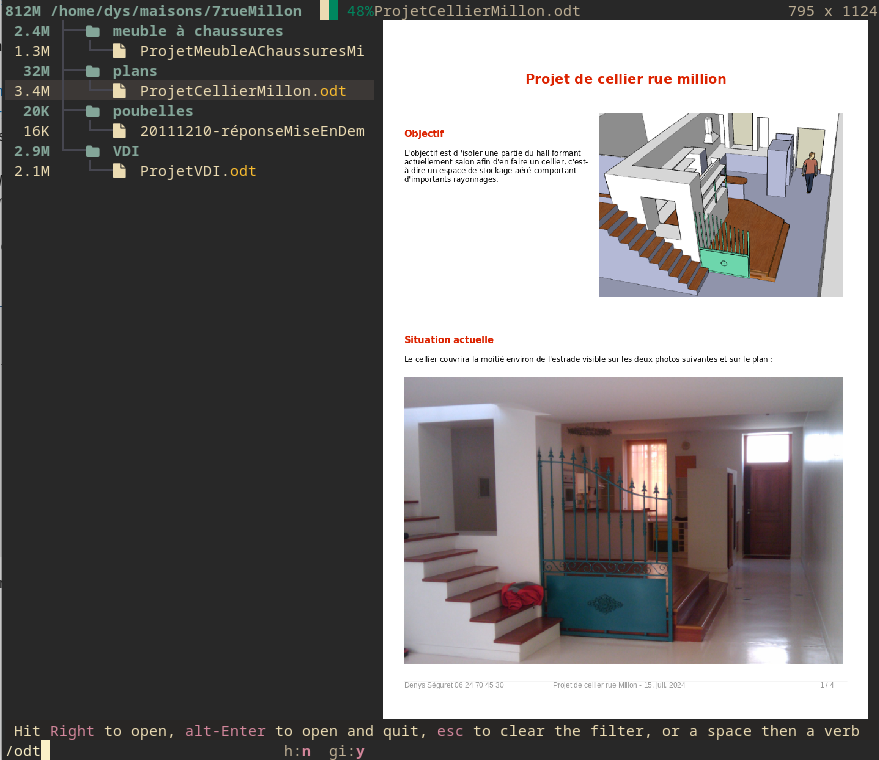
{
input_extensions: [ "xls", "xlsx", "doc", "docx", "ppt", "pptx", "ods", "odt", "odp" ]
output_extension: png
mode: image
command: [
"libreoffice", "--headless",
"--convert-to", "png",
"--outdir", "{output-dir}",
"{input-path}"
]
}
Beautify JSON using jq
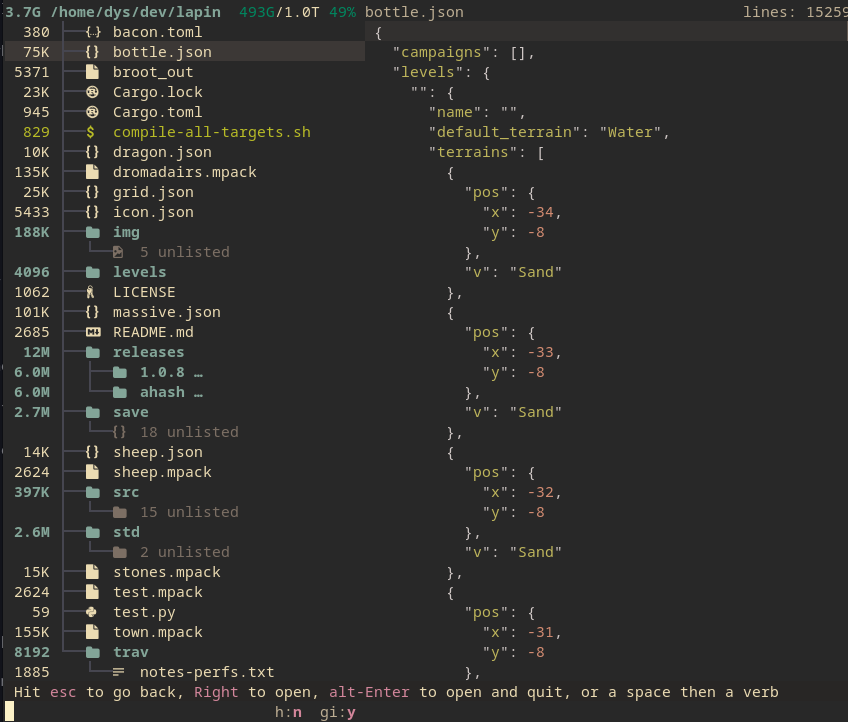
# Use jq to beautify JSON
# In this example, the command refers to neither the input nor the output,
# so broot pipes them to the stdin and stdout of the jq process
{
input_extensions: [ "json" ]
output_extension: json
mode: text
command: [ "jq" ]
}
Match surroundings
You may limit the filtered view to just the matching lines:
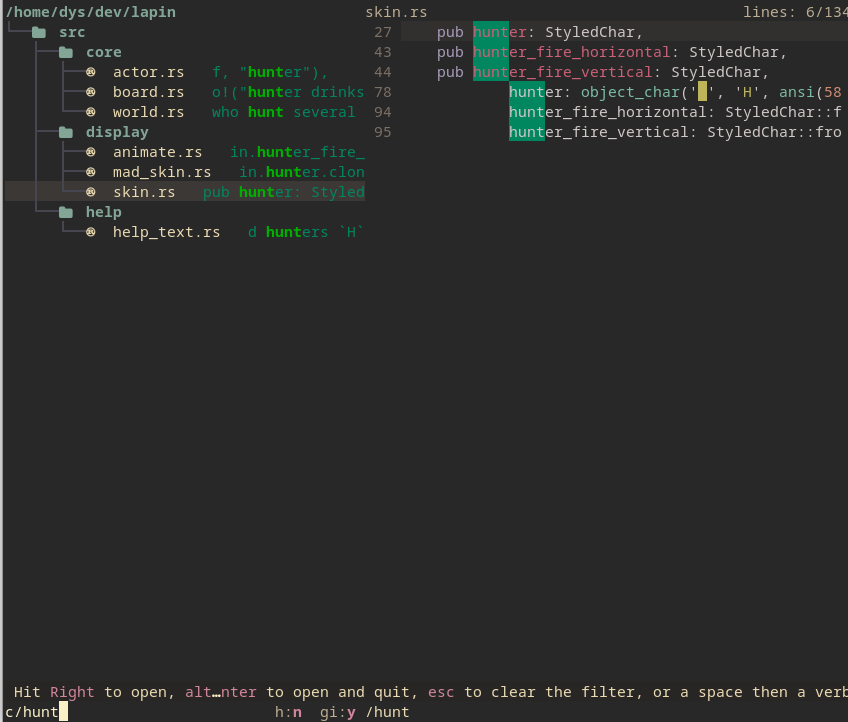
But if you want to have more than just the matching lines displayed in preview, you may set those parameters to
lines_before_match_in_preview: 1
lines_after_match_in_preview: 1
lines_before_match_in_preview = 1
lines_after_match_in_preview = 1
And you'll get

Miscellaneous
Keyboard enhancements
By default, ANSI terminals make a lot of keyboard combinations impossible, for example spacen, or altab, or shiftspace, etc. Some terminals implement Kitty's keyboard protocol and basically make it possible to bind verbs to such combinations.
Broot tests whether the terminal supports those enhancements, and if it's the case, tries to enable them.
A small downside is that broot will react on key release instead of key press (so that you may press other keys before you release the first one), which may feel less instant. If the Kitty protocol isn't supported by your terminal, broot will react on key press. Another problem is that it may push you towards key combinations that you wouldn't be able to reuse when switching terminal. And finally, some terminals have buggy implementations (at time of writing).
To enable those keyboard enhancements change this setting to true
enable_kitty_keyboard: true
enable_kitty_keyboard = true
Max staged count
This is the maximal number of files added by a :stage_all_files command
max_staged_count: 1234
max_staged_count = 1234
Mouse Capture
Broot usually captures the mouse so that you can click or double click on items. If you want to disable this capture, you may add this:
capture_mouse: false
capture_mouse = false
File Sum Threads Count
This is the number of threads used for directory size computation. Most users should not change this. In my measurements a number of 4 to 6 looks optimal.
file_sum_threads_count: 10,
file_sum_threads_count = 10
Quit on last cancel
You can usually cancel the last state change on escape.
If you want the escape key to quit broot when there's nothing to cancel (for example when you just opened broot), you can set quit_on_last_cancel to true:
quit_on_last_cancel: true
quit_on_last_cancel = true
Update broot's work dir
By default, the work dir of the broot process is synchronized with the root of the current panel. If you prefer to keep the work dir unchanged, disable this feature with
update_work_dir: false
update_work_dir = false
Pattern match display
When your search pattern is applied to a path, the path is shown on each line so that you see why the line matches:
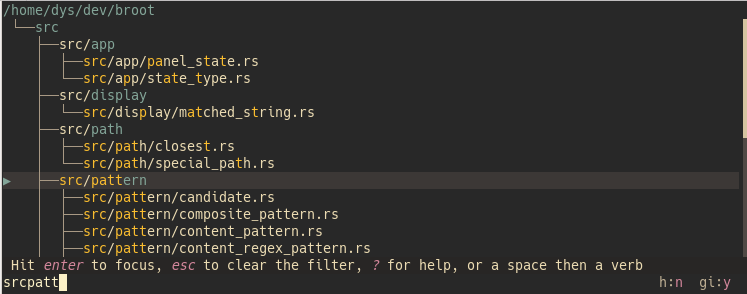
If you don't really need to see matching characters, you may get a cleaner display with just file names with this option:
show_matching_characters_on_path_searches: false
show_matching_characters_on_path_searches = false
which gives this:
